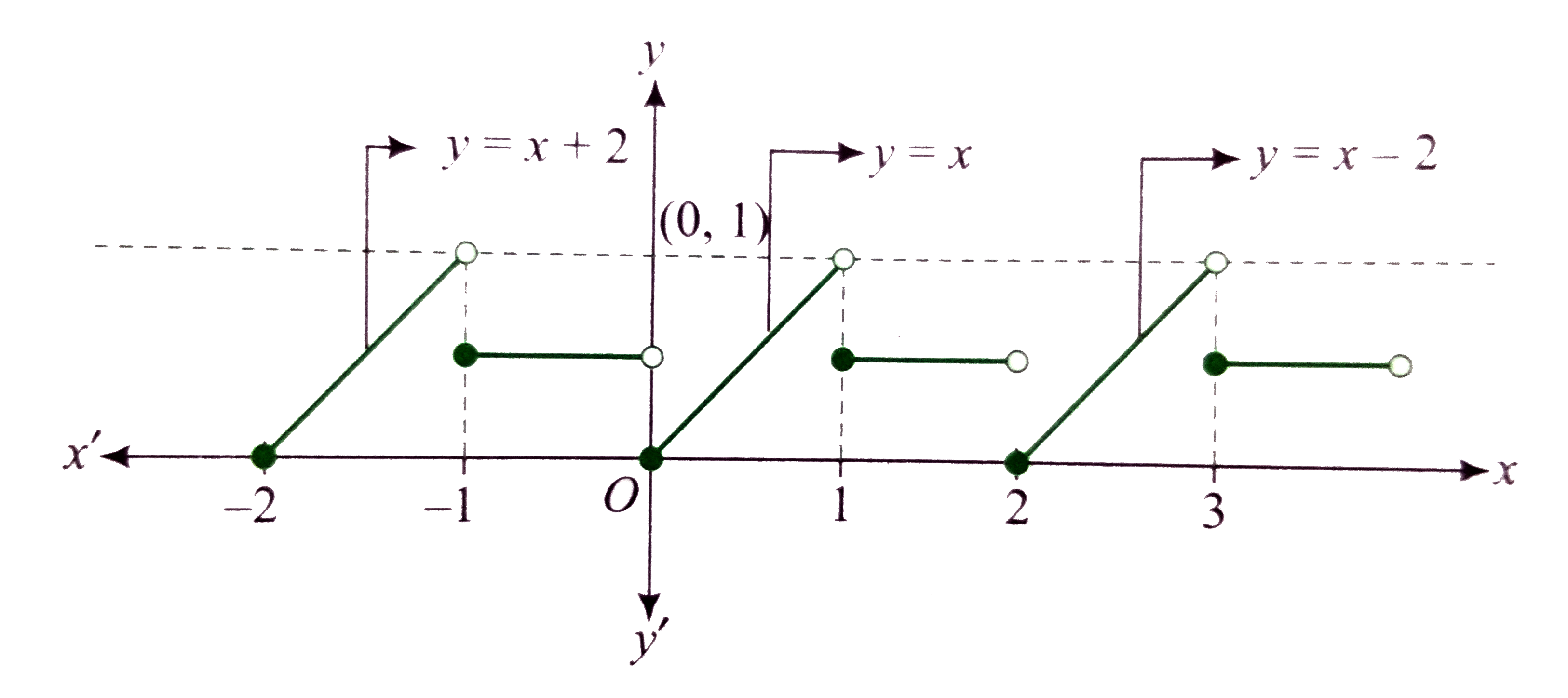Which of the following function is/are periodic?
A. f(x)={1x is rational0x is irrational
B. f(x)={x−[x]2n≤x<2n+1122n+1≤x<2n+2
where [.] denotes the greatest integer function n∈Z
C.
f(x)=(−1)2xπ, where [.] denotes the greatest integer function
D.
f(x)=x−[x+3]+tan(πx2), where [.] denotes the greatest integer function, and a is a rational numberSolution in Bengali
f(x)={1,x is rational0,x is irrational
f(x)={x−[x],2n≤x<2n+112,2n+1≤x<2n+2
where [.] denotes the greatest integer function n∈Z
f(x)=(−1)[2xπ], where [.] denotes the greatest integer function
f(x)=x−[x+3]+tan(πx2), where [.] denotes the greatest integer function, and a is a rational number
The correct Answer is:A, B, C, D
f(x)={1,x is rational0,x is irrational
orf(x+k)={1,x+k is rational0,x+k is irrational, where k is any rational number
={1,x is rational0,x is irrational
=f(x)
Therefore, f(x) is periodic function, but its fundamental period cannot be determined. Thus,
f(x)={x−[x],2n≤x<2n+11/2,2n+1≤x<2n+2
Draw the graph from which it can be verified that period is 2.

f(x)=(−1)[2xπ]
orf(x+π)=(−1)[2(π+x)π]=(−1)[2xπ]+2=(−1)[2xπ]
Hence, the period is π.
f(x)=x−[x+3]+tan(πx2)={x}−3+tan(πx2)
{x} is periodic with period 1,tan(πx2)x is period with period 2.
Now, the LCM of 1 and 2 is 2. Hence, the period of f(x) is 2.
Topper's Solved these Questions
Similar Questions
Let ABCandABC' be two non-congruent triangles with sides AB=4,AC=AC′=2√2 and angle B=300 . The absolute value of the difference between the areas of these triangles is
05:00View SolutionNumber of integral value(s) of λ for which vectors x2ˆi−ˆj+xˆk,(λ−1)ˆi−2λˆj−ˆk and ˆi−ˆj+ˆk, in the order form right-handed system ∀x ∈R, is
(a) 0 (b) 2 (c) 4 (d) 601:57View Solutionf(x)=lim_(n rarr oo)sin^(2n)(pi x)+[x+(1)/(2)], where [.] denotes the greatest integer function,is
05:29View SolutionThe range of f(x)=(2+x-[x])/(1-x+[x]). where [1] denotes the greatest integer function is
02:36View SolutionThe function,f(x)=[|x|]-|[x]| where [] denotes greatest integer function:
01:59View Solutionf(x)=1+[cos x]x, in 0<=x<=(x)/(2) (where [.] denotes greatest integer function)
01:13View SolutionLet f(x)=(-1)^([x]) where [.] denotes the greatest integer function),then
04:08View SolutionIf [.] denotes the greatest integer function, then f(x)=[x]+[x+12]
05:06View SolutionFor a function f(x)=2(x2+1)[x] (where [.] denotes the greatest integer function), if 1≤x<4. Then
04:00View SolutionThe function f(x)=limn→∞cos2n(πx)+[x] is (where, [.] denotes the greatest integer function and n∈N)
08:09View SolutionIf f(x)=[x]tan(πx) then f'(k+)is equal to (where k is some integer and [.] denotes greatest integer function)
02:53View Solutionf(x)=limn→∞cos2n(πx2)+[x] (where, [.] denotes the greatest integer function and n∈N) is
07:22View SolutionThe value of ∫20π−20π|sinx|[sinx]dx is (where [.] denotes greatest integer function)
02:27View Solutionf(x)=limn→∞sin2n(πx)+[x+12], where [.] denotes the greatest integer function, is
03:33View SolutionThe function, f(x)=[|x|]−|[x]| where [] denotes greatest integer function:
02:06View SolutionIf [.] denotes the greatest integer function, then f(x)=[x]+[x+12]
17:39View Solution

